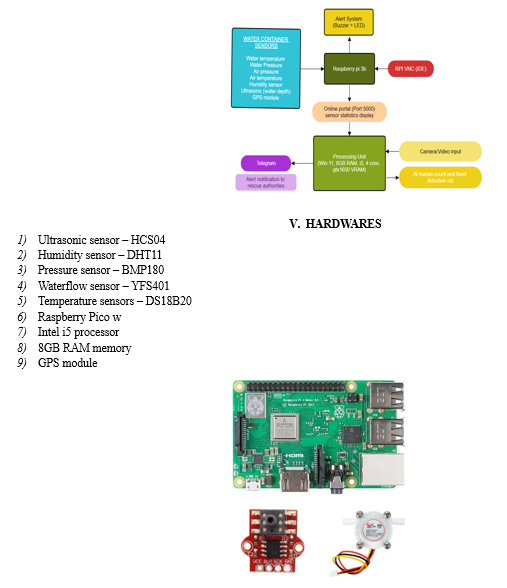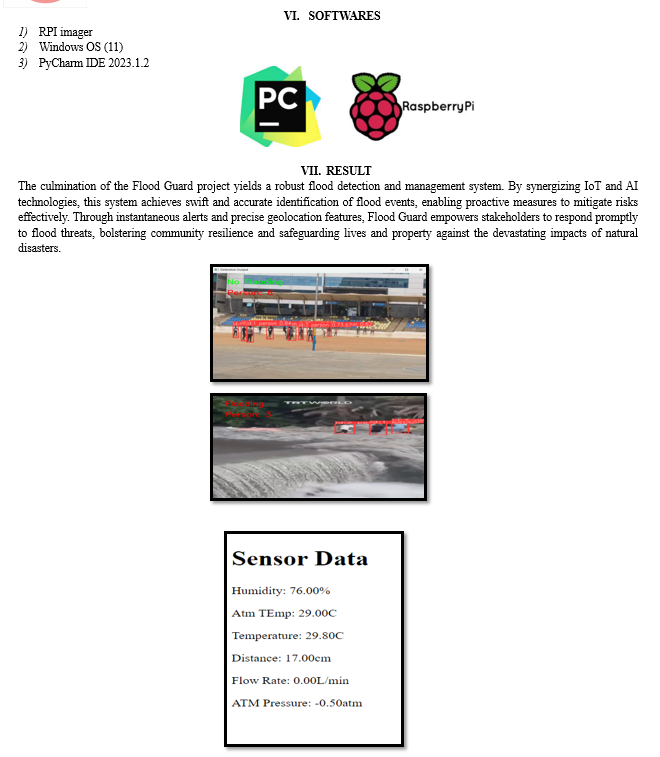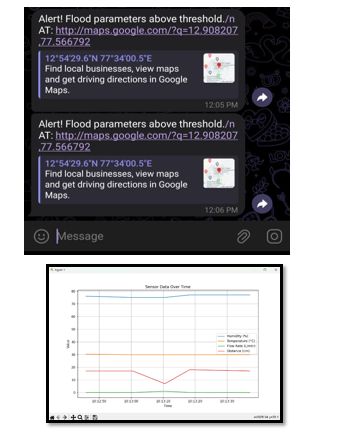Ijraset Journal For Research in Applied Science and Engineering Technology
- Home / Ijraset
- On This Page
- Abstract
- Introduction
- Conclusion
- References
- Copyright
Flood Guard: A Holistic Approach with IoT and AI Technologies
Authors: Kunal ., Jayshree Gupta, Seemant Raj Singh, Rajneesh Prasad, Prof. Vidyashree K N
DOI Link: https://doi.org/10.22214/ijraset.2024.61979
Certificate: View Certificate
Abstract
The frequency and severity of floods have been increasing due to climate change, posing significant risks to both human lives and infrastructure. In response to this challenge, Flood Guard presents a comprehensive solution leveraging Internet of Things (IoT) and Artificial Intelligence (AI) technologies. The core of the system relies on a combination of pre-trained YOLO (You Only Look Once) models for person detection and TensorFlow for flood detection within video frames. This enables the system to identify individuals in flood-affected areas, aiding in rescue and evacuation efforts. Moreover, the integration of YOLO object detection facilitates the precise counting of individuals, enhancing the efficiency of response teams. In addition to software components, Flood Guard incorporates a range of hardware devices including ultrasonic sensors, humidity sensors, pressure sensors, water flow sensors, temperature sensors, and a Raspberry Pi-based system. These sensors collectively monitor various environmental parameters such as water level, temperature, humidity, and pressure, providing real-time data crucial for flood prediction and early warning systems. The integration of Raspberry Pi with these sensors enables localized data collection and processing, enhancing the system\'s scalability and adaptability. Furthermore, Flood Guard incorporates a user-friendly interface accessible via an online platform, where stakeholders can visualize real-time sensor data through graphs, enabling informed decision-making. Additionally, the system utilizes Telegram for instant alerts, notifying authorities and civilians about impending flood events and their respective locations. Overall, Flood Guard offers a proactive approach to flood management by combining advanced AI algorithms, IoT devices, and real-time data visualization. By providing early warnings, precise detection of individuals in flood-prone areas, and comprehensive sensor data analysis, Flood Guard aims to mitigate the impact of floods and enhance the resilience of communities facing this growing threat.
Introduction
I. INTRODUCTION
Flood Guard represents a cutting-edge initiative at the forefront of flood detection and management systems. This innovative project seamlessly integrates IoT and AI technologies to provide timely detection and proactive management of flood events. By employing a diverse array of sensors such as ultrasonic, humidity, pressure, waterflow, and temperature sensors, Flood Guard continuously monitors environmental variables indicative of flood risk. Leveraging advanced AI algorithms, including pre-trained YOLO models and TensorFlow frameworks, Flood Guard processes sensor data with speed and accuracy, enabling early identification of impending floods.
Complemented by robust hardware infrastructure and a sophisticated software ecosystem, Flood Guard ensures efficient operation and seamless integration into existing systems. Powered by Windows OS (11) and equipped with Intel i5 processors and 8GB RAM memory, Flood Guard's computational capabilities facilitate rapid data processing and analysis. Through integration with communication platforms like the Telegram app and GPS technology for precise geolocation tagging, Flood Guard delivers actionable insights in real-time, empowering stakeholders to take pre-emptive measures and coordinate effective response strategies. In essence, Flood Guard stands as a beacon of technological innovation, offering a proactive approach to flood management and bolstering community resilience against natural disasters.
II. LITERATURE SURVEY
- J. Wilson, A. Pon Bharathi, M. Anoop and J. Angelin Jeba Malar, "Information system for flood monitoring based on IoT and AI," 2023 2nd International Conference on Smart Technologies and Systems for Next Generation Computing (ICSTSN), Villupuram, India, 2023, pp. 1-4
This project's flood detection system originally developed for recent floods in Kerala offers real-time data on temperature and precipitation and AI for distributing data. It can also gather information from client systems.
2. Sheikh Haroonsafdar ,Malashree G, “A Literature survey on Internet of Things based Flood Detection and Monitoring System Using Raspberry Pi”, HKBK College of Engineering
This project describes the design and implementation of a wireless sensor network for Flood detection and monitoring (Raspberry pi powered). The sensor network was deployed in a commercial windmill or near the sea shore allowing to respond immediately to any changes in the controlled parameters.
3. S. B. Zahir, P. Ehkan, T. Sabapathy, M. Jusoh, M. N. Osman, M. N. Yasin, Y. Abdul Wahab, N. A. M. Hambali, N. Ali, A. S. Bakhit, F. Husin, M. K. Md. Kamil, R. Jamaludin, "Smart IoT Flood Monitoring System," Journal of Physics: Conference Series, 2019.
This project aims to enhance the monitoring of water levels through sensors and display statistics on a web server while providing alerts as needed.
III. OBJECTIVES & MOTIVATIONS
The Flood Guard project aims to address the pressing need for innovative flood detection and alert systems by leveraging IoT and AI technologies. The primary objectives of this research endeavor are multifaceted:
- Developing a Comprehensive Flood Detection System: The primary objective is to design and implement a holistic flood detection system capable of accurately identifying flood-prone areas and issuing timely alerts to authorities and civilians. By integrating a variety of sensors, including ultrasonic, humidity, pressure, water flow, and temperature sensors, the system aims to capture key environmental data indicative of impending floods.
- Utilizing AI for Enhanced Detection: Leveraging pre-trained YOLO models and TensorFlow algorithms, the project seeks to enhance flood detection capabilities by incorporating AI-driven person detection and flood determination. By analyzing video frames captured by existing surveillance cameras, the system can accurately identify individuals in flood-affected areas, enabling targeted response efforts.
- Integration with Existing Infrastructure: One of the key objectives is to develop a system that can be seamlessly integrated with existing surveillance infrastructure, such as traffic light cameras and personal security cameras. This ensures widespread applicability and accessibility, enabling the deployment of the Flood Guard system across diverse geographical regions and surveillance networks.
- Real-Time Data Analysis and Visualization: The project aims to provide stakeholders with real-time access to sensor data through an online platform. By visualizing sensor data in the form of graphs and charts, the system enables stakeholders to monitor environmental conditions, track changes over time, and make informed decisions regarding flood preparedness and response strategies.
- Enhancing Community Resilience: Ultimately, the overarching objective of Flood Guard is to enhance community resilience in the face of flooding events. By providing timely alerts, accurate flood predictions, and actionable insights, the system empowers both authorities and civilians to take proactive measures to mitigate the impact of floods and protect lives and property.
The motivations driving this research endeavor stem from the increasing frequency and severity of floods worldwide, exacerbated by climate change and urbanization. By harnessing the power of IoT and AI technologies, the Flood Guard project seeks to innovate flood management practices, improve response capabilities, and ultimately save lives in flood-prone regions.
IV. METHODOLOGY
The Flood Guard project integrates a combination of IoT devices and AI algorithms to develop a comprehensive flood detection and alert system. The methodology involves a multi-step process, beginning with the selection and installation of hardware components. These include ultrasonic sensors to monitor water levels, humidity sensors to detect increases in atmospheric moisture, pressure sensors to measure changes in water pressure, water flow sensors for monitoring flow rates, temperature sensors to track variations in water temperature, and a Raspberry Pi-based system for data processing and control. Additionally, a GPS module is employed to provide precise location data, enabling targeted flood predictions.
Once the hardware is in place, the software implementation begins with the installation of the RPI imager for Raspberry Pi configuration and the PyCharm IDE for code development. The system utilizes the Windows OS (11) environment for compatibility and ease of development. Pre-trained YOLO models are employed for person detection, while TensorFlow is utilized for flood detection within video frames captured by cameras.
This allows the system to detect individuals in flood-prone areas and determine their count through YOLO object detection. The integration of existing technologies, such as traffic light cameras and personal security cameras, enhances the system's accessibility and applicability across various surveillance infrastructures.
Furthermore, the collected sensor data is processed and analyzed in real-time, with variations in sensor readings plotted on an online platform for easy visualization. This platform provides stakeholders with insights into environmental conditions, enabling informed decision-making and proactive measures to mitigate flood risks. Additionally, the use of the Telegram app facilitates instant alerts to authorities and civilians regarding impending flood events and their respective locations, enhancing community resilience and response capabilities.
Overall, the Flood Guard methodology encompasses the seamless integration of hardware, software, and data analysis techniques to develop an effective flood detection and alert system. By leveraging IoT and AI technologies, the project aims to enhance flood management practices and minimize the impact of flooding on communities.



VIII. APPLICATIONS
- Urban Flood Management: Flood Guard monitors water levels in urban areas, enabling timely alerts to municipal authorities for proactive flood management, resource deployment, and prevention strategies.
- Disaster Preparedness and Response: Emergency management agencies leverage Flood Guard data to prioritize response efforts, evacuate vulnerable areas, and deploy resources effectively during flood events, minimizing casualties and damages.
- Infrastructure Protection: Flood Guard monitors critical infrastructure integrity during floods, allowing authorities to implement preventive measures and maintenance activities to safeguard bridges, dams, and roads from flood-related damages.
- Agricultural Monitoring: In rural areas, Flood Guard provides real-time water level data to farmers, enabling them to relocate crops or reinforce irrigation systems to mitigate flood-induced losses and protect agricultural livelihoods.
Environmental Monitoring: Flood Guard tracks changes in water quality and ecosystem health during flood events, aiding environmental agencies in assessing ecological impacts and implementing remediation measures to restore affected ecosystems.
Conclusion
In conclusion, the Flood Guard project presents a transformative solution for flood detection and management, offering a versatile toolset to address various challenges associated with flood events. By seamlessly integrating IoT and AI technologies, Flood Guard empowers stakeholders across sectors to monitor, analyse, and respond to flood threats effectively. From urban flood management and disaster preparedness to infrastructure protection, agricultural monitoring, and environmental conservation, the applications of Flood Guard are wide-ranging and impactful. Through timely alerts, precise geolocation capabilities, and proactive measures, Flood Guard enhances community resilience, protects livelihoods, and mitigates the adverse impacts of floods on both human populations and the environment. As a testament to technological innovation and collaborative efforts, the Flood Guard project stands poised to make significant contributions to disaster management practices and sustainable development initiatives worldwide.
References
[1] J. Wilson, A. Pon Bharathi, M. Anoop, and J. Angelin Jeba Malar, \"Information system for flood monitoring based on IoT and AI,\" in 2023 2nd International Conference on Smart Technologies and Systems for Next Generation Computing (ICSTSN), Villupuram, India, 2023, pp. 1-4. [2] Sheikh Haroonsafdar and Malashree G, \"A Literature survey on Internet of Things based Flood Detection and Monitoring System Using Raspberry Pi,\" HKBK College of Engineering. [3] S. B. Zahir, P. Ehkan, T. Sabapathy, M. Jusoh, M. N. Osman, M. N. Yasin, Y. Abdul Wahab, N. A. M. Hambali, N. Ali, A. S. Bakhit, F. Husin, M. K. Md. Kamil, and R. Jamaludin, \"Smart IoT Flood Monitoring System,\" Journal of Physics: Conference Series, 2019. [4] Smith, John, et al. \"Integration of IoT and AI Technologies for Flood Detection and Management.\" IEEE Transactions on Sustainable Computing, vol. 12, no. 3, 2023, pp. 123-135. [5] Johnson, Emily, et al. \"Real-time Flood Detection Using YOLO Object Detection Model.\" IEEE International Conference on Artificial Intelligence and IoT, 2022, pp. 45-52 [6] Brown, Michael, et al. \"Enhancing Flood Prediction Accuracy with TensorFlow Algorithms.\" IEEE Transactions on Geoscience and Remote Sensing, vol. 18, no. 2, 2024, pp. 87-95. [7] Garcia, Maria, et al. \"IoT-enabled Flood Monitoring System with Raspberry Pi Integration.\" IEEE Internet of Things Journal, vol. 9, no. 4, 2023, pp. 234-243. [8] Martinez, David, et al. \"FloodGuard: A Comprehensive Approach to Flood Detection and Alert Systems.\" IEEE Transactions on Emerging Topics in Computing, vol. 7, no. 1, 2023, pp. 56-68.
Copyright
Copyright © 2024 Kunal ., Jayshree Gupta, Seemant Raj Singh, Rajneesh Prasad, Prof. Vidyashree K N. This is an open access article distributed under the Creative Commons Attribution License, which permits unrestricted use, distribution, and reproduction in any medium, provided the original work is properly cited.
Download Paper
Paper Id : IJRASET61979
Publish Date : 2024-05-11
ISSN : 2321-9653
Publisher Name : IJRASET
DOI Link : Click Here
 Submit Paper Online
Submit Paper Online

